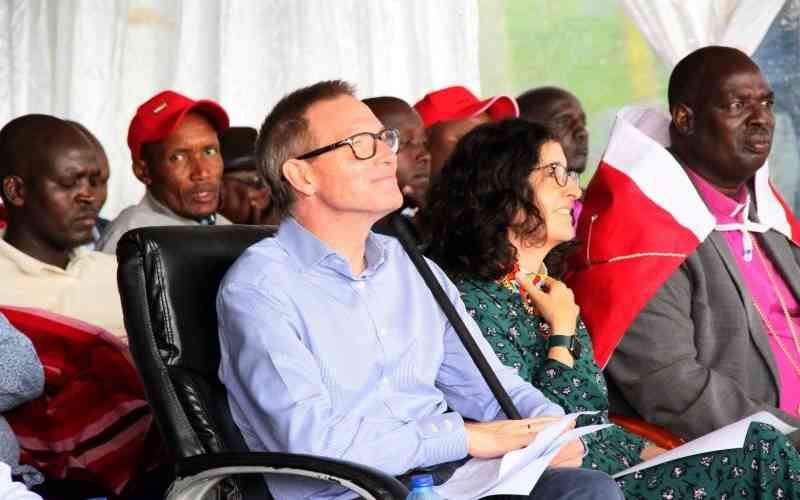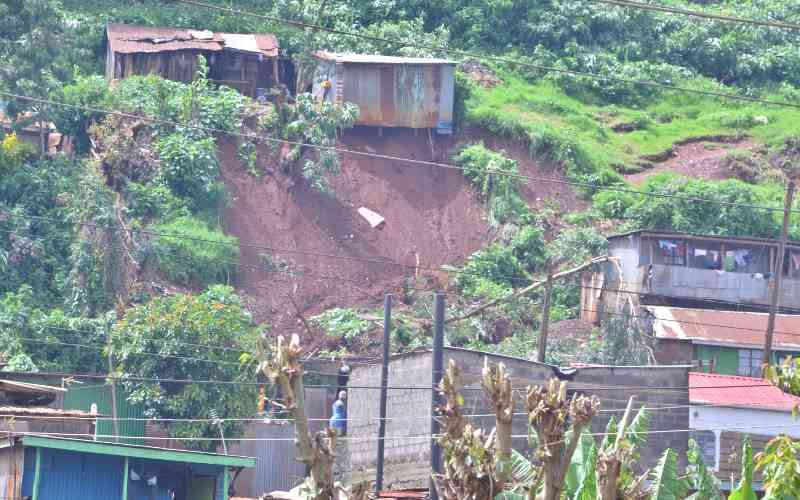 |
|
Pupils share desks and have to contend with dilapidated infrastructure. [PHOTOS: KAMAU MAICHUHIE/STANDARD] |
Nairobi, Kenya: When the Narc Government introduced Free Primary Education in 2003, it was sweet music to the ears of hundreds of thousands of parents who were struggling to pay fees.
The move came as a relief since the burden of keeping children in school had been taken off parents’ shoulders by the Exchequer in collaboration with development partners.
But the programme came with new challenges, top on the list being the high enrollment made worse by lack of basic facilities and equipment in almost all public primary schools.
From a distance, Mwiki Primary School in Githurai, Kiambu County, exhibits no outward sign of a struggling institution. The din from the modest playground seems to affirm that everything is fine at the school.
However, upon closer scrutiny and interaction with teachers, parents and pupils, shocking revelations come to the fore.
The school, sitting on a plot measuring 84 metres by 86 metres (smaller than a soccer pitch) is perhaps the most densely populated public primary school in Kenya. It has a population of 2,700 pupils.
According to head teacher Joseph Kamau, the numbers are no longer sustainable.
Kamau says the situation is made worse by limited space and lack of classrooms, toilets and playground. “We feel the problem is a ticking time bomb that should be dealt with before it is too late,” Kamau told The Standard on Sunday.
The school has 22 toilets, which are in deplorable condition. Kamau says the institution needs 40 additional toilets. Learning is almost becoming impossible since a classroom, which measures 14 square feet, hosts between 100 and 130 pupils. The number is far beyond the international and national standards of between 45 and 50 pupils per classroom.
Here, about four pupils share a desk. In some classes that have higher numbers, five pupils share a desk.
No playground
The head teacher says 40 additional classrooms are required to ease the congestion. “As the school administration, we feel the congestion is dangerous,” said Kamau. The school does not have a playground. According to the head teacher, when the pupils prepare for games, the school closes one of the adjacent roads from where they practice, a trend that compromises movement and business within the local community.
The school assembles three times a week and only in shifts since the entire school population cannot fit in the compound for a session. But the school enjoys the services of 67 teachers, 70 per cent of whom are university graduates. Four are currently pursuing their masters’ degrees and one is researching for her doctrate.
Teachers at the school confess that the high pupil numbers has brought with it problems. Mary Mungai, a Kiswahili/CRE teacher, says pupil-teacher interaction is compromised. She says marking homework and exams is a formidable challenge since there are more than a hundred pupils per class and a teacher has several classes to attend to.
A parent, Janet Mwikali, says the situation at the school is worrying. She says many parents consider their children lucky each time they return home in one piece.
Stay informed. Subscribe to our newsletter
“Since we do not have money to send them to private academies in the area, we are forced to enroll them in this public school even when we know the dangers they are exposed to,” says Mwikali.
The school Pupils’ President, Peter Deng, said the sheer population has affected the quality of learning.
“Many pupils do not do their homework and the teachers can’t effectively monitor their progress. Many also miss classes without being noticed,” Deng said.
But despite these challenges, Mwiki Primary is among the best performing schools in Kiambu County. The head teacher said last year, more than 10 pupils qualified for national schools with many others joining provincial and county secondary schools.
He also says indiscipline is not much of a problem. And once in school, pupils seldom leave unnoticed, a situation he attributes to a perimeter wall they recently erected around the school, thanks to area MP Esther Gathogo’s intervention.
No response
The Chairman of the School Board of Management, Mr Simon Matheka, says the school has written several letters to the Ministry of Education seeking help but there has been no response.
Kiambu County Quality Assurance and Standards Officer Teresiah Nyaga would not comment on the issue of overcrowding which is common in rural schools across the country.
However, a senior Ministry of Education official who spoke on condition of anonymity, said the Government was aware of the overcrowding and would address it.
Left with little hope and with no help coming their way, the parents are now organising a fund-raiser next month to help expand the school.
They are targeting to raise Sh40 million to construct a five-storey building aimed at alleviating the acute shortage of classrooms. They plan to collect Sh24 million in October and Sh16 million early next year to fund the construction.
The 2,500 parents are each contributing Sh2,000 in the hope that their children will benefit.
 The Standard Group Plc is a
multi-media organization with investments in media platforms spanning newspaper
print operations, television, radio broadcasting, digital and online services. The
Standard Group is recognized as a leading multi-media house in Kenya with a key
influence in matters of national and international interest.
The Standard Group Plc is a
multi-media organization with investments in media platforms spanning newspaper
print operations, television, radio broadcasting, digital and online services. The
Standard Group is recognized as a leading multi-media house in Kenya with a key
influence in matters of national and international interest.
 The Standard Group Plc is a
multi-media organization with investments in media platforms spanning newspaper
print operations, television, radio broadcasting, digital and online services. The
Standard Group is recognized as a leading multi-media house in Kenya with a key
influence in matters of national and international interest.
The Standard Group Plc is a
multi-media organization with investments in media platforms spanning newspaper
print operations, television, radio broadcasting, digital and online services. The
Standard Group is recognized as a leading multi-media house in Kenya with a key
influence in matters of national and international interest.










